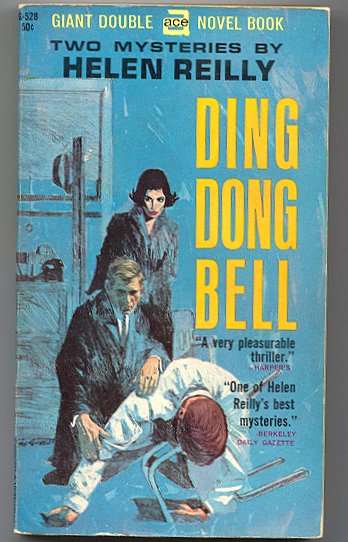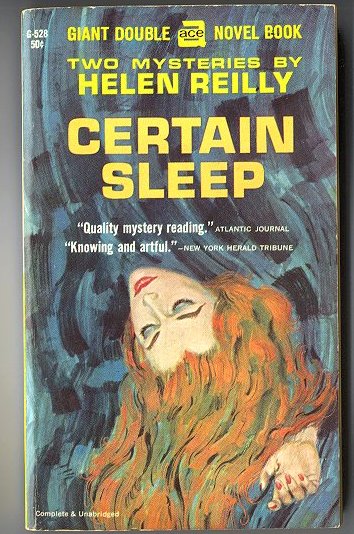Book Review: Ding Dong Bell | Certain Sleep by Helen Reilly
It’s time for another Ace Double, paperbacks with two short books bound upside down from each other. This one, G-528, is from the Giant Double Novel Book series of mysteries. Although it wasn’t advertised as such, this line was entirely devoted to female authors. Helen Reilly (1891-1962) was a popular mystery novelist from the 1930s-1950s, primarily known for her Inspector McKee series. The head of the fictional Manhattan Homicide Squad, he ran for 31 books, and the two reprinted here are near the end of the run.

Ding, Dong, Bell: It is April 1958 and Liz Bowen is looking forward to a May marriage to attractive widower Philip Montgomery. This weekend, she’s going up to Spuyten Duyvil, where she’ll meet some of Philip’s people, including his adult stepdaughter Carol, and determine if they’ll want to live in the house Philip inherited from his wife Sarah. To Liz’s shock, Carol is now dating Delphin Saunders, Liz’s ex-fiancé, who she has very bad memories of. Also present among the guests, but leaving quickly, is a private detective named Adams, who has news of Sarah’s previous maid Jane, who had disappeared along with some jewelry.
When Liz returns to downtown Manhattan, she gets a call from Mr. Adams, who wants to talk about something that happened three years ago. Fearing that he might know the truth, she heads to the detective’s office. When she arrives, Mr. Adams is already dead–or so she claims. She does, however, tamper with the crime scene by burning the last few pages in his appointment book along with any other papers she can find. Philip arrives (or is he coming back?) and also tampers with the crime scene.
Inspector McKee is set back by these actions. We learn that Adams was known as a blackmailer, and apparently he’d struck paydirt in Spuyten Duyvil as several people in and around the Montgomery household have juicy secrets. It seems likely that one of them murdered Adams to silence him, but which one?
We alternate between the perspectives of Liz, trying to navigate the fraught social circle which contains at least one murderer (who will strike again) and McKee, trying to piece together the truth.
By the end, we learn both who the murderer is, and what Liz’s secret was. The latter is as expected more sympathetic than most, though it would still inflict social death on someone.

Certain Sleep: August 18, 1961 is when it began. Jo Dobenny is in Stonyford, Connecticut to visit her invalid cousin Philip and his wife Docia in the town where they grew up. She’s trying to ignore that a short walk away, her ex-lover Bob Lansing is living with the heiress he abruptly married, Hester. It’s a scorcher, threatening rain but that probably won’t clear the air.
Hester summons Jo to her manor, accuses Jo of still seeing Bob, and hints at dark secrets, but a) is clearly drunk, and b) is interrupted by a crash in the house before she can get down to specifics. When Hester doesn’t return, Jo starts home and gets caught in the storm. She realizes she left her purse on the Lansing grounds and arrives back just in time to dimly see Hester in her trademark yellow scarf driving off in her fancy Duesenberg.
The next morning, Hester is found in an unfinished parking lot, the car’s exhaust pipe jammed into a berm of dirt, and she’s dead, probably from carbon monoxide poisoning. As it just so happens, Inspector McKee was staying at the nearby hotel on his way back to New York and takes an interest in the case. He discovers clues that make him think this isn’t suicide or death by misadventure…but murder!
Incompetent local police chief Baker has a personal grudge against Bob, so isn’t looking any further for suspects. Not that Bob is helping himself, as he’s concealing certain of his movements on the night in question, and has asked Jo to do the same. McKee asks Highway Patrol officer Sullivan to keep an eye on things, and loans him an operative named Todhunter to do some digging.
Turns out Hester wasn’t a pleasant person, and there are multiple people who’d have a motive to kill her, even leaving aside her pile of money.
This one has a particularly twisty solution, especially in regard to Jo’s own future.
These stories are very similar in their narrative choices, and having most of the characters be either financially comfortable or coming from families that used to have money. In the first one, there’s a distinct bit of classism, as an (unworn) female underwear set from a particular downmarket store is found in Adams’ office, and Liz is insulted that McKee would think she’d ever shop there.
They’re competently written mysteries, but the second one seems to shoehorn in McKee just to have the series credit.
It’s sometimes expensive to find particular Ace Doubles, but a fair amount of Mrs. Reilly’s work is on Kindle and other should be locatable at used book stores. Recommended to fans of Fifties mysteries.

